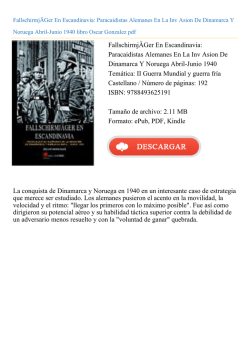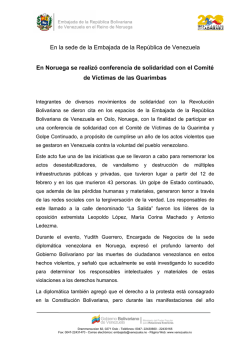
Snøhetta - Arquitectura Viva
AV Monografías Monographs 177 (2015) Snøhetta 25 Years, 25 Works AV Monografías Monographs 177 (2015) SNØHETTA 25 Years, 25 Works Director Editor Luis Fernández-Galiano Director adjunto Deputy Editor José Yuste Redacción Layout/Editorial Cuca Flores Eduardo Prieto Laura F. Suárez Miguel Fernández-Galiano Maite Báguena Raquel Vázquez Pablo Canga Miguel de la Ossa Alicia Gutiérrez Mar Pérez-Ayala Coordinación editorial Coordination Laura Mulas Gina Cariño Producción Production Laura González Jesús Pascual Administración Administration Francisco Soler Suscripciones Subscriptions Lola González Distribución Distribution Mar Rodríguez Publicidad Advertising Cecilia Rodríguez Teresa Maza Editor Publisher Arquitectura Viva SL Calle Aniceto Marinas, 32 E-28008 Madrid, España Tel: (+34) 915 487 317 Fax: (+34) 915 488 191 [email protected] www.ArquitecturaViva.com AV Monografías es miembro de ARCE Precio en España 30 euros © Arquitectura Viva 3 Luis Fernández-Galiano Caminantes Wayfarers Noruega y global Norwegian and Global 6 Craig Dykers ¿Por qué (nos) importa? Why (Do We) Bother? 10 Ingerid Helsing Almaas Una conversación permanente On-Going Conversations Diez edificios Ten Buildings 20 Biblioteca Alexandrina, 1989-2001, Alejandría (Egipto) Bibliotheca Alexandrina, 1989-2001, Alexandria (Egypt) 28 Museo de Pesca de Karmøy, 1998, Karmøy (Noruega) Karmøy Fishing Museum, 1998, Karmøy (Norway) 30 Ópera y Ballet Nacional de Noruega, 2000-2008, Oslo (Noruega) Norwegian National Opera and Ballet, 2000-2008, Oslo (Norway) 38 Museo Petter Dass, 2001-2007, Alstahaug (Noruega) Petter Dass Museum, 2001-2007, Alstahaug (Norway) 44 Pabellón del Museo Memorial del 11-S, 2004-2014, Nueva York (EE UU) National September 11 Memorial Museum Pavilion, 2004-2014, New York (USA) 48 Centro Escénico Isabel Bader, 2007-2014, Kingston, Ontario (Canadá) Isabel Bader Centre for the Performing Arts, 2007-2014, Kingston, Ontario (Canada) 54 Biblioteca James B. Hunt Jr., 2008-2013, Raleigh (EE UU) James B. Hunt Jr. Library, 2008-2013, Raleigh (USA) 60 Centro de aprendizaje de la Universidad Ryerson, 2009-2015, Toronto (Canadá) Ryerson University Student Learning Centre, 2009-2015, Toronto (Canada) 66 Powerhouse Kjørbo, 2012-2014, Bærum (Noruega) Powerhouse Kjørbo, 2012-2014, Bærum (Norway) 68 Casa Piloto ZEB, 2014, Larvik (Noruega) ZEB Pilot House, 2014, Larvik (Norway) Cinco intervenciones Five Structures 72 Escenario cubierto Tuballoon, 2006, Kongsberg (Noruega) Tuballoon Band Shelter, 2006, Kongsberg (Norway) 74 Ruta de turismo Eggum, 2007, Lofoten (Noruega) Eggum Tourist Route, 2007, Lofoten (Norway) 76 Pabellón del reno salvaje Tverrfjellhytta, 2009-2011, Dovre (Noruega) Tverrfjellhytta Wild Reindeer Pavilion, 2009-2011, Dovre (Norway) 80 Pabellón en College Park, 2013, Dallas, Texas (EE UU) Dallas Park Pavilion, 2013, Texas (USA) 82 Estación Central, 2014-, Houston, Texas (EE UU) Central Station, 2014-, Houston, Texas (USA) Diez proyectos Ten Projects Esta revista recibió una ayuda a la edición del Ministerio de Educación, Cultura y Deporte en 2014 Todos los derechos reservados All rights reserved Depósito legal Legal registration: M-17054-2015 ISSN: 0213-487X ISBN: 978-84-606-8376-6 Impresión Printing: Artes Gráficas Palermo Cubierta Cover Pabellón Tverrfjellhytta, Dovre (Noruega) (© Roger Brennhagen) Traducciones Translations Laura Mulas, Miguel Fernández-Galiano, Eduardo Prieto 86 Centro cultural King Abdulaziz, 2007-2016, Dhahran (Arabia Saudí) King Abdulaziz Center for World Culture, 2007-2016, Dhahran (Saudi Arabia) 90 Remodelación de Times Square, 2010-2015, Nueva York (EE UU) Times Square Reconstruction, 2010-2015, New York (USA) 94 Museo de Ciencias Ambientales, 2010-2017, Guadalajara (México) Natural Science Museum, 2010-2017, Guadalajara (Mexico) 96 Parque Max Lab IV, 2011-2016, Lund (Suecia) Max Lab IV Landscape, 2011-2016, Lund (Sweden) 98 Ópera de Busan, 2012-2020, Busan (Corea del Sur) Busan Opera House, 2012-2020, Busan (South Korea) 100 Estación de metro en Riad, 2012-2017, Riad (Arabia Saudí) Riyadh Metro Station, 2012-2017, Riyadh (Saudi Arabia) 102 Centro de arte paleolítico Lascaux IV, 2013-, Montignac (Francia) Lascaux IV Caves Museum, 2013-, Montignac (France) 104 Ampliación del SFMOMA, 2013-2016, San Francisco, California (EE UU) SFMOMA Expansion, 2013-2016, San Francisco, California (USA) 108 Nueva Biblioteca Central de Calgary, 2013-2018, Calgary, Alberta (Canadá) Calgary’s New Central Library, 2013-2018, Calgary, Alberta (Canada) 110 Hotel Lofoten Opera, 2014-, Lofoten (Noruega) Lofoten Opera Hotel, 2014-, Lofoten (Norway) Caminantes Wayfarers El estadounidense Craig Dykers y el noruego Kjetil Trædal Thorsen han recorrido un largo camino en un cuarto de siglo. Desde el concurso de la Biblioteca de Alejandría en 1989 hasta la inauguración en Nueva York del Pabellón Memorial del 11 de septiembre en 2014, los fundadores de Snøhetta han vagado como los personajes de Knut Hamsun a la sombra de la capucha de nieve de su nombre elegido, en un itinerario sin otra brújula que el paisaje y la vida. Ayunos de identidad formal, pero desbordantes de intensidad proyectual, han sabido fertilizar su diversidad cultural con el espíritu cívico escandinavo en las cubiertas transitables de su colosal Ópera de Oslo, y sus diferentes orígenes con el amor a la naturaleza del mundo nórdico en el cálido interior del diminuto Pabellón del reno salvaje: dos obras antagónicas en su localización, propósito y escala, y sin embargo subterráneamente vinculadas por su sensibilidad escultórica y su celebración de la vida humana o animal. Con oficinas en Oslo y Nueva York —y estudios en San Francisco, Innsbruck y Singapur—, Snøhetta se ha convertido en una marca global sin perder sus testarudas raíces noruegas; ha sido capaz de obtener el reconocimiento de galardones internacionales tan diferentes en su enfoque como el Premio Aga Khan (en 2004 por la Biblioteca de Alejandría) y el Premio Mies van der Rohe (en 2009 por la Ópera de Oslo); y ha extendido su trabajo desde las grandes construcciones monumentales hasta el diseño gráfico, del que son buen ejemplo los nuevos billetes noruegos, que representan con musical abstracción los paisajes míticos de un país que encabeza todos los rankings de riqueza y desarollo humano. Impulsada por el maná del petróleo, pero también por un pragmatismo que combina la pertenencia a la OTAN con el rechazo de la Unión Europea, la Noruega de hoy puede mirarse en el espejo de Snøhetta como la del pasado reciente lo hizo en el de Sverre Fehn. Estas luces del norte iluminan un trayecto colectivo en el que no han faltado las sombras. La Noruega romántica y popular del músico Edvard Grieg fue también la que retratan los dramas de Henrik Ibsen, de Casa de muñecas a El pato salvaje: el siglo XIX no se reduce a la fantasía de Peer Gynt; el país primitivo y esencial de Hamsun se reconocería igualmente en la angustia expresionista del pintor Edvard Munch; y los paisajes líricos de Fehn coexistirían con el mundo tenebroso del Black Metal. Snøhetta, una aventura creativa noruega y global, exhibe los mejores rasgos de una nación modélica, pero se enfrenta también a la erosión de los valores en la sociedad contemporánea que han documentado sus novelistas policíacos, desde Jo Nesbø, Karin Fossum o Kjell Ola Dahl hasta Anne Holt, exministra de Justicia de un país que perdió la inocencia con la matanza de Utøya, y que aquí homenajeamos con la madera noruega y los bueyes almizcleros de estos caminantes tenaces. Luis Fernández-Galiano The American Craig Dykers and the Norwegian Kjetil Trædal Thorsen have walked a long way in twenty-five years. From the competition for Bibliotheca Alexandrina in 1989 to the opening in New York of the September 11 Pavilion in 2014, the founders of Snøhetta have wandered like the characters of Knut Hamsun in the shadow of the snow hood of their chosen name, with no other compass than landscape and life. Showing greater design intensity than formal identity, they have fertilized their cultural diversity with Scandinavian civic spirit in the accessible roofs of their colossal Opera House in Oslo, and their mixed backgrounds with Nordic love for nature in the warm interior of the tiny Wild Reindeer Pavilion: two contrasting works in location, purpose and scale, and yet linked by their sculptural slant and their celebration of human and animal life. With studios in Oslo and New York – and ateliers in San Francisco, Innsbruck and Singapore –, Snøhetta has become a global brand without losing its stubborn Norwegian roots; it has merited the recognition of awards so different in approach as the Aga Khan (in 2004 for Bibliotheca Alexandrina) and the Mies van der Rohe (in 2009 for the Oslo Opera House); and has extended its work from the large monumental constructions to graphic design, a good example of which are the new Norwegian banknotes, which represent with musical abstraction the mythical landscapes of a country that tops all the rankings of wealth or human development. Driven by the manna of oil, but also by a pragmatism where NATO membership is combined with the rejection of the EU, today’s Norway can see itself reflected in the mirror of Snøhetta, just as it did in that of Sverre Fehn not so long ago. These northern lights fall on a path that has its shadows. The romantic Norway of Grieg was also the one portrayed in the dramas of Ibsen, from A Doll’s House to The Wild Duck: the 19th century was not only that of Peer Gynt’s fantasy; the essential country of Hamsun would find a counterpoint in the expressionist angst of Munch; and the lyrical landscapes of Fehn would coexist with the dark world of Black Metal. Snøhetta, a Norwegian and global creative quest, displays the best features of a model nation, but must also deal with the contemporary erosion of values described by its crime novelists, from Jo Nesbø, Karin Fossum or Kjell Ola Dahl to Anne Holt, former Minister of Justice in a country that lost its innocence with the Utøya massacre, and that is homaged here with the Norwegian wood and the musk oxen herds of these resilient wayfarers. AV Monographs 177 2015 3
© Copyright 2025


